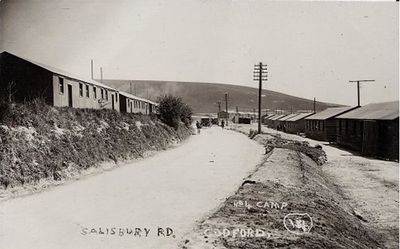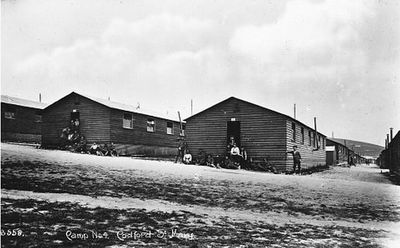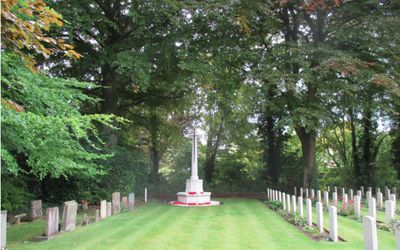Difference between revisions of "Codford"
From Our Contribution
(→Soldiers who passed this way) |
(→Soldiers who passed this way) |
||
| Line 48: | Line 48: | ||
* [[James Edward Grabham]] 16 Nov 1916 - 9 Dec 1918 - 13th Training Battalion & 12th Training Battalion cadres. | * [[James Edward Grabham]] 16 Nov 1916 - 9 Dec 1918 - 13th Training Battalion & 12th Training Battalion cadres. | ||
* [[Victor Emanuel Durling]] 18 Nov - 1 Jul 1917 - 13th Training Battalion | * [[Victor Emanuel Durling]] 18 Nov - 1 Jul 1917 - 13th Training Battalion | ||
| − | * [[William Francis Cohn]] 20 Nov - 20 Dec 1916 - | + | * [[William Francis Cohn]] 20 Nov - 20 Dec 1916 - Codford General Hospital |
* [[Archibald Shepherd]] 3 Dec 1917 - 4 Feb 1918 - 11th Training Battalion | * [[Archibald Shepherd]] 3 Dec 1917 - 4 Feb 1918 - 11th Training Battalion | ||
* [[William Wright Casterton MM]] 13 Dec 1916 - 3 Feb 1917 - 11th Training Battalion | * [[William Wright Casterton MM]] 13 Dec 1916 - 3 Feb 1917 - 11th Training Battalion | ||
| + | * [[Albert Tom Milton]] 26 Dec 1916 - ?? - Codford General Hospital | ||
* [[Patrick Francis Fitzgerald]] 29 Dec 1916 - 14 Feb 1917 - 12th Training Battalion | * [[Patrick Francis Fitzgerald]] 29 Dec 1916 - 14 Feb 1917 - 12th Training Battalion | ||
Revision as of 17:37, 17 September 2021
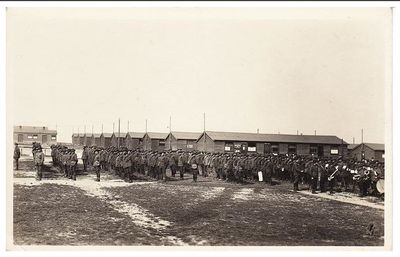 Codford Camp and Australian soldiers | |
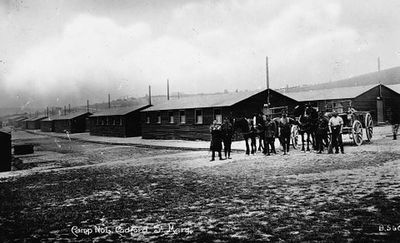 Number 1 Camp at Codford St Mary's | |
Remarks
With its easy rail and road access to Warminster and Salisbury, during the First World War, there were no fewer than 15 different camps built in and around Codford. Initially this was to accommodate British troops before their deployment to France but after 1916 for New Zealand troops. The Australian No. 4 Command Depot (for the men who had been evacuated from the front line and were not yet fit to return to the front) arrived from Wareham in Dorset, remaining at Codford until November when it moved to Hurdcott.
During World War I large training and transfer camps were established in the surrounding area for the tens of thousands of Australian troops waiting to move to France. Codford also became a depot in 1916 for the men who had been evacuated from the front line and were not fit to return to the front.
The remains of rows of temporary wooden huts can be seen to the north of St Mary's church stretching along the eastern side of the Chitterne Road. Also clearly visible are the earthworks associated with the Codford Camp Railway that linked the civilian station with the camp sites.
Codford's 'Anzac Badge' was the idea of an Australian Brigade Commander during World War I, who wished to leave a visible memento of his brigade when it departed. This consists of a gigantic Rising Sun badge (measuring 53 x 45 metres), carved in 1916 into the grass of a hillside to expose the underlying bright white chalk. The soldiers of 13 Trg Bn AIF who maintained the badge as a form of punishment named the site 'Misery Hill'.
The meticulously maintained Commonwealth War Graves Commission cemetery nearby is the second largest New Zealand War Grave Cemetery in the UK, and contains the graves of 97 Anzac troops, 66 New Zealanders, and 31 Australians.
Soldiers who passed this way
1916
- Samuel Buckland 12 Feb 1916 - 4 Jul 1917
- William Francis Cohn 20 Nov - 20 Dec 1916 - Codford General Hospital
- Charles Blunt 3 Dec 1916 - 24 Jun 1917 - 13th Training Battalion
- James Edward Grabham 16 Nov 1916 - 9 Dec 1918 - 13th Training Battalion & 12th Training Battalion cadres.
- Victor Emanuel Durling 18 Nov - 1 Jul 1917 - 13th Training Battalion
- William Francis Cohn 20 Nov - 20 Dec 1916 - Codford General Hospital
- Archibald Shepherd 3 Dec 1917 - 4 Feb 1918 - 11th Training Battalion
- William Wright Casterton MM 13 Dec 1916 - 3 Feb 1917 - 11th Training Battalion
- Albert Tom Milton 26 Dec 1916 - ?? - Codford General Hospital
- Patrick Francis Fitzgerald 29 Dec 1916 - 14 Feb 1917 - 12th Training Battalion
1917
- Robert Prior Bailey 11 Jan - 4 May 1917 - 4th Training Battalion
- Charles Leonard Lockhart 11 Jan - 8 May 1917 - 3rd Training Battalion
- George Mouatt Dow 4 Mar - 28 May 1917 - 12th Training Battalion
- William Percival Nairn 4 Mar - 1 Jul 1917 - 12th Training Battalion
- James Peter Henderson MM & Bar 27 Mar - 30 May 1917 - 4th Training Battalion
- Stanley Thomas Marsh 28 Mar - 24 Jun 1917 - 13th Training Battalion
- Henry (Harry) Butcher 30 Apr - 10 May 1917 - 51st Battalion reinforcement cadre
- Harold Percival Martin 9 Jul 1917 - 15 Jan 1918 - 4th Training Battalion
- † John James Gill 26 Aug - 3 Dec 1917 - 4th Training Battalion
- Alfred Gittins 26 Aug - 2 Oct 1917 - 4th Training Battalion
- John Harold Coffen 28 Aug - 5 Oct 1917
- Victor Norman Chandler MM 3 Sep - 10 Oct 1917 - 13th Training Battalion
- Eugene Anthony Gillespie 15 Sep 1917 - 22 Jan 1918 - 4th and 13th Training Battalions
- Lancel Butcher 25 Sep - 26 Nov 1917
- Victor Norman Chandler MM 11 Oct 1917 - 29 Jan 1918 - Instructional staff
1918
- Leonard George Morgan 5 Jan - 30 Mar 1918 - 4th Division Signals School
- James Owen Horrocks 28 Mar - 28 Aug 1918 - 4th Division Signals School
- Harry Simpson Francis 5 Apr - 30 May 1918
- George Emanuel Harber 4 Jun 1918 - 18 Mar 1919 - Instructional staff
1919
- Alfred Arthur Martin 7 - 27 Feb 1919 - 2nd Training Brigade
- Lewis George Martin 3 Apr - 31 May 1919
- Thomas Frederick McDonough 7 Apr - 5 Jun 1919
- James Arnold 8 Apr - 31 May 1919
- William Edwin Cousens MM 8 Apr - 31 May 1919
- Percy Fleming 8 Apr - 31 May 1919
- Thomas McGow 8 Apr - 5 Jun 1919
- Bruce Leslie Logan 19 Apr - 14 Jun 1919
- Albert John Harris 14 May - 28 Jul 1919
Notes
